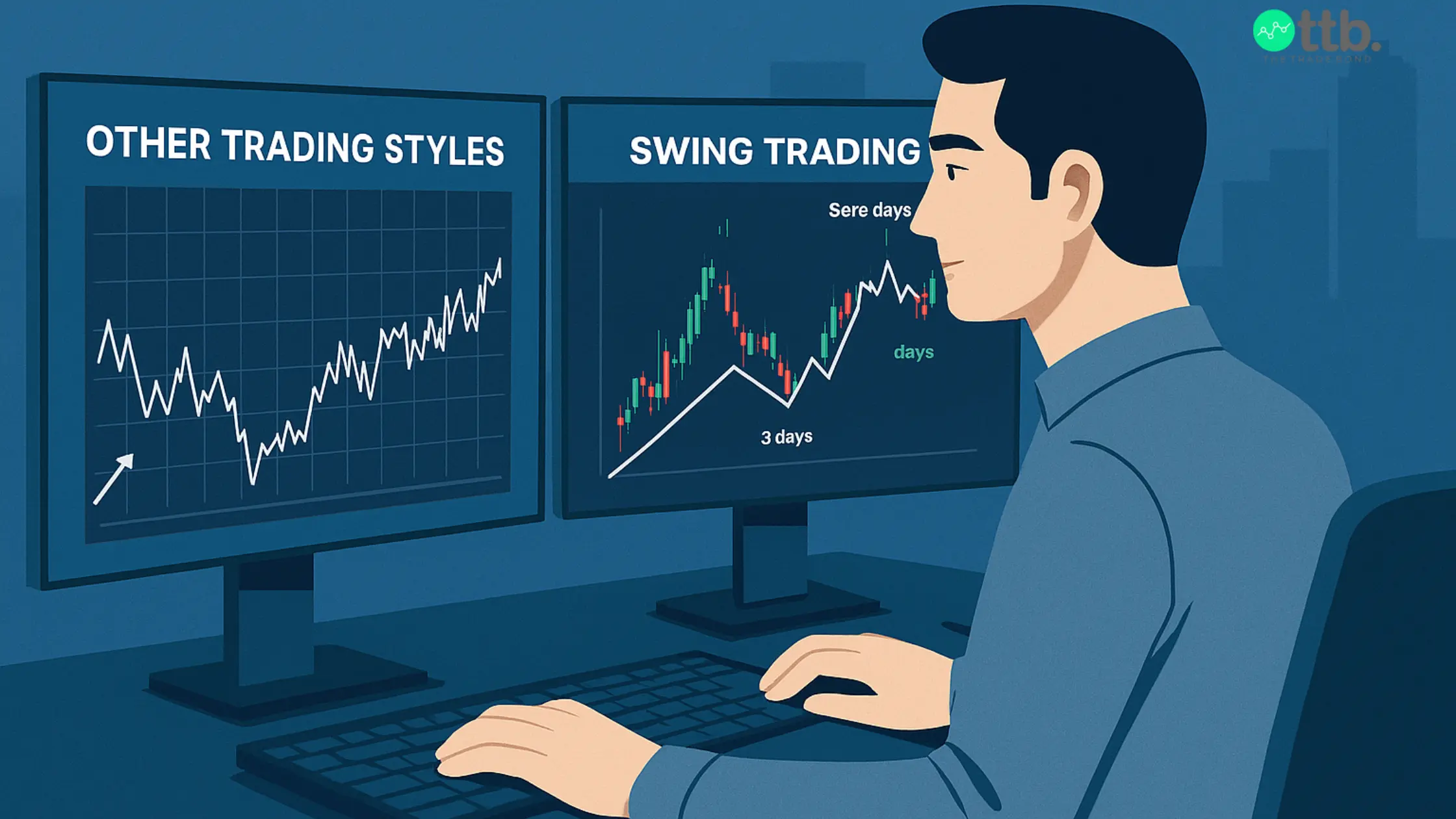Swing Trading vs Other Trading Styles in India

Understanding Swing Trading vs Other Trading Styles
When traders explore the stock market, they often come across different trading styles. Trading styles such as scalping, intraday, short-term, and long-term investing. To really understand these trading styles, it’s important to know how each one works in different market conditions. Among these segments, swing trading is considered the best trading segment. Because it captures short-term to medium-term price movements that often last from a few days to weeks.
In this blog, we’ll discuss swing trading vs other trading styles. And also, we help you to understand how swing trading differs from other segments. Also, you will see why many part-time traders prefer this style and how they identify trading opportunities using daily and weekly charts.
Why Swing Traders Focus on Trends While Scalpers Chase Tricks
The major difference between swing traders and scalpers is their time period and way of approach.
Scalpers look for quick, small moves to enter and exit trades within minutes. So, their goal is to capture small price fluctuations multiple times a day. Therefore, this trading style requires constant screen time and quick reactions.
Swing traders focus on identifying trends. Therefore, they analyze different chart patterns, technical indicators, and market momentum to find price swings.
Instead of reacting to every trade, swing traders prefer to hold their positions for a few days. Therefore, they use tools like moving averages or MACD to find right entry and exit points.
If you’re interested in learning more about identifying trends and timing trades effectively. Visit our detailed guide on swing trading tips.
Swing Trading vs Intraday: Risk and Reward Comparison
Comparing swing trading vs intraday, the contrast lies in risk management and reward potential.
Intraday traders open and close all trades within the same day. Therefore, they depend mostly on short-term volatility to avoid overnight positions. This will help out to reduce exposure to aftermarket movements. However, they need to manage constant intraday fluctuations.
Therefore, by holding trades for a few days, they give the market more time to develop trends with a balanced approach. Hence, overnight risk exists, but there’s a chance to benefit from gap openings and broader price movements.
From a risk perspective, swing trading needs small position sizes but wider stop-losses. Coming to intraday trading, it uses tighter stop-losses but frequent entries.
Want to learn how to manage exposure in different market conditions, contact our stock market tips provider. Also, check out our insights on the stock future tips page.
The Real Difference Between Swing and Short-Term Trading
They both look similar, but there’s a clear difference between swing trading and short-term trading.
Short-term trading refers to trades that last from a few days to a month. This will often merge with multiple trading styles together. It focuses on company specific news.
Meanwhile, swing trading is more technical in nature. Therefore, it mainly focuses on price action and momentum, not on news or reports.
A swing trader waits patiently for the price to pull back to a support zone or break a resistance level before entering any trade.
In simple terms, short-term trading is broader, while swing trading is more pattern-based and trend-following.
Read our blog on the best swing trading strategies for part-time traders. It explains how to plan your entries and exits without spending all day in monitoring.
Can Swing Trading Create Wealth Like Long-Term Investing?
This is a common question, especially from traders who compare swing trading vs other trading styles like long-term investing. So, the answer depends on your goal and mindset.
Long-term investors can hold their positions over the years by focusing on company growth, dividends, and compounding.
Coming to swing traders, they focus on market cycles to capture repeated movements within an ongoing trend.
While long-term investing builds wealth slowly, swing trading offers the opportunity to increase returns through regular participation to find short-term price movements. However, it also requires discipline, research, and understanding of market conditions.
Check out our blog on how stock market changes effect swing trading. And also, understand how market sentiment influences this trading style.
Daily vs Weekly Charts: How Swing Traders Find Their Edge
Chart timeframe is one of the main tools that gives swing traders an edge.
Daily Charts:
These are used to identify short-term setups such as breakout or reversal patterns.
Weekly Charts:
With the help of these charts, traders see the broader trends. Also, they’re useful to filter false signals that appear in daily or hourly timeframes.
Why do most swing traders use a combination of both?
Traders first look at weekly charts to define the trend direction, then plan their entries using daily charts. Therefore, this multi-frame analysis gives them a balanced view of risk and opportunity.
For part-time traders, this approach is enough because it doesn’t need continuous monitoring. With the help of why swing trading is popular for part-time traders blog learn about time-efficient methods.
The Trade Bond’s View on Swing Trading vs Other Trading Styles
At The Trade Bond, we believe that understanding your trading personality is the key to success. Swing trading offers a flexible balance between time commitment and potential reward. Thus, making it ideal for individuals who cannot monitor the markets all day but want to stay active.
Compared to other market segments, swing trading offers a trend-based approach. Hence, it allows traders to steadily grow with patience and proper planning. Whether you’re analyzing daily setups or weekly patterns, mastering one that suits you is important.
Check out our service pages like swing trading tips and stock future tips. These pages are designed to build a strong foundation for your journey with The Trade Bond.
FAQ's
Is swing trading good for part-time traders in India?
Yes, swing trading is good choice for part-time traders in India. Because they no need to do full-day monitoring like intraday trading. So, you can study charts after market hours and plan trades for next day.
What indicators do swing traders follow?
They follow indicators such as moving averages, MACD, and RSI to check trends and entry points. With the help of these tools you can decide when to buy or sell.
Can swing trading work in Indian markets like Nifty or Bank Nifty?
Yes, swing trading works well in Indian markets. Many traders use it on Bank Nifty and Nifty stocks. Because, these markets show clear price movements. You can check out our Bank Nifty tips page here for more insights.
